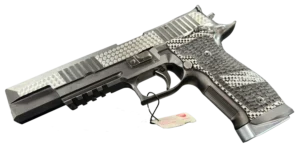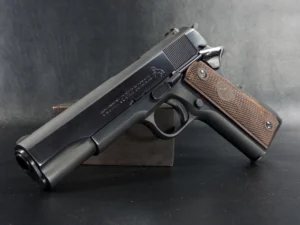Key Takeaways:
- Revolutionary Design, Unrealized Potential: The Heckler & Koch G11 was a groundbreaking attempt to reinvent the assault rifle using caseless ammunition. It offered reduced weight, increased fire rate, and mechanical simplicity. Despite its technical innovations, it was never mass-produced due to high complexity, cost, and shifting geopolitical priorities.
- Caseless Ammunition: Innovation and Obstacles: The G11’s caseless ammo concept eliminated the need for traditional brass casings, promising operational advantages; however, challenges like heat management (cook-off) and sealing led to extensive R&D efforts. Though partially solved, these issues contributed to skepticism and resistance within NATO and the U.S. military.
- Legacy and Influence Beyond the Battlefield: Although the G11 never saw service, its technologies influenced future designs, such as the G36 and the U.S. LSAT program. It remains a symbol of Cold War-era ambition and a cult favorite among military historians and firearms enthusiasts, often cited as a visionary concept ahead of its time.
The Heckler & Koch G11 stands as one of the most ambitious and visionary firearm designs of the 20th century. At its core was a revolutionary idea: to eliminate the brass casing from ammunition, creating a lighter and more efficient rifle for modern warfare. Driven by Cold War urgency and Germany’s search for technological superiority, the G11 was the centerpiece of a decades-long quest to redefine infantry small arms. Despite its unprecedented innovation, the G11 ultimately never saw full-scale deployment. Its journey from concept to prototype and its abrupt cancellation reflect both the promise and peril of pushing military technology to its extremes.
The Cold War Context: A Call for Innovation
In the wake of World War II, West Germany rebuilt its military doctrine in accordance with NATO. By the 1960s, the Bundeswehr was rearming with the G3 battle rifle, a reliable but heavy and long rifle chambered in 7.62×51mm NATO. The G3 offered range and power, but lacked controllability in automatic fire, especially during mobile operations. Submachine guns, on the other hand, were compact but too limited in range and power.
Germany envisioned something better: a lightweight, compact rifle capable of both precision and suppressive fire, and one that would leapfrog traditional ammunition design entirely. This was not merely an evolution of the assault rifle—it was an attempt to reinvent it.
In 1967, West Germany’s Ministry of Defense greenlit a bold program to create a second-generation infantry weapon. This system would fire caseless ammunition, a radical departure from conventional brass-cased rounds. The benefits were enticing—reduced weight, more ammunition per soldier, and simplified weapon design—but the technical hurdles were daunting.
The Caseless Ammunition Concept
At the heart of the G11 project was caseless ammunition, a concept that promised to eliminate spent cartridge ejection, reduce mechanical complexity, and significantly lighten a soldier’s combat load. Each G11 round featured a solid block of propellant encasing the bullet, with no metal case. Upon firing, the entire cartridge was consumed, leaving no residue to eject.
However, caseless ammunition faced two critical challenges:
- Cook-off: With no casing to absorb and eject heat, residual chamber temperature could ignite rounds prematurely.
- Sealing: Traditional brass casings expand upon firing to seal the chamber, preventing gas leakage. Caseless rounds had no such mechanism.
These issues had plagued previous attempts at caseless ammo dating back to the 19th century. To overcome them, Germany enlisted Dynamit Nobel, a leader in chemical engineering, to develop a new high-ignition temperature propellant (HITP). Combined with advanced polymers and coatings, this formulation minimized the risk of cook-off and made caseless rounds more feasible than ever before.
Engineering the Impossible: The Heckler & Koch Partnership
Heckler & Koch, already a respected innovator in small arms, led the mechanical development of the rifle itself. The company partnered with Dynamit Nobel and Hensoldt AG, an optics specialist responsible for the G3’s scopes. This triad of firms would form the Gesellschaft für Hülsenlose Gewehrsysteme (GSHG)—the Association for Caseless Rifle Systems.
HK’s engineers faced an immense task: build a rifle that could reliably fire fragile caseless rounds at a high rate without jamming, overheating, or malfunctioning. Over the next two decades, the G11 would evolve through numerous prototypes—each one a masterclass in engineering complexity.
Key innovations included:
- Rotating Chamber: A vertical-to-horizontal rotating breech chamber that loaded rounds from the top and rotated them into alignment with the barrel.
- Floating Barrel System: The barrel and mechanism were mounted on internal springs, which reduced felt recoil and allowed the weapon to fire three rounds before recoil was even sensed.
- Integrated Optics: Hensoldt designed a specialized reflex and later telescopic sight specifically for the G11, improving rapid target acquisition.
Prototype Progression and NATO Involvement
The G11 development journey was punctuated by rigorous testing and redesigns. Between 1970 and 1981, HK produced at least six major prototypes:
- Prototype 1: Proved the feasibility of firing caseless ammo but struggled with reliability.
- Prototype 3: Incorporated a roller-locked bolt system, improving durability and feeding.
- Prototype 6: Introduced rear-ignition ammunition and enhanced chamber sealing, marking a significant step toward operational viability.
During this time, West Germany was designated as NATO’s lead developer for a second-generation infantry rifle. This gave the G11 strategic importance within the alliance. In 1977, NATO conducted comparative trials featuring the G11, the UK’s SA80, France’s FAMAS, Belgium’s FNC, and the US M16A1 with experimental XM777 ammunition.
The G11 impressed with its innovative design, lightweight construction, and accuracy. However, its complexity and high production costs raised eyebrows, and NATO was hesitant to abandon the 5.56mm standard. Still, Germany pressed forward.
From NATO to the U.S. ACR Trials
By the mid-1980s, with the G11 nearing maturity, attention turned to the U.S. market. The American Advanced Combat Rifle (ACR) program aimed to double the hit probability over the M16. HK entered the G11 in a specially configured variant—the G11 ACR—and was awarded $3.8 million to prepare and deliver test units.
The G11 ACR fired at an astounding 2,100 rounds per minute in three-round burst mode, designed to place multiple rounds in a tight spread before recoil affected the shooter’s aim. This “hyperburst” technique significantly increased hit probability during suppression and close engagements.
While testers acknowledged the weapon’s potential, concerns remained:
- Environmental sensitivity of caseless ammo
- Maintenance demands
- Complexity of training and operation
Ultimately, none of the ACR program rifles met the U.S. Army’s criteria for doubling hit probability, and the program ended in 1990 with no winner.
The G11 K2: Final Refinement
The G11 K2, finalized in 1989, was the pinnacle of the program. It featured:
- A modular magazine system holding three magazines simultaneously for quick reloads
- Improved sealing and ignition mechanisms
- Upgraded Hensoldt telescopic optics
- Simplified maintenance procedures
Field trials were conducted with the Bundeswehr’s airborne and mountain warfare units, reconnaissance schools, and mechanized forces. Soldiers praised its accuracy, controllability, and weight savings. The G11 K2 was certified for service in April 1990 and slated for procurement.
The German government even budgeted for 300,000 rifles with an expected total cost of 2.7 billion Deutsche Marks.
The Fall: Politics and Pragmatism
Just as the G11 stood on the verge of adoption, history intervened. In late 1989, the Berlin Wall fell, and by 1990, German reunification was underway. The sudden end of the Cold War reshaped military priorities.
Several factors doomed the G11:
- Surplus Weapons: East Germany’s AK-74s flooded into Bundeswehr inventories, negating the urgent need for a new rifle.
- Budget Constraints: Reunification costs redirected defense funding toward rebuilding infrastructure and integrating the former East.
- NATO Incompatibility: The G11’s 4.73×33mm caseless round did not match NATO’s 5.56mm standard. Germany stood alone in its support.
- Logistical Headaches: Adopting a unique ammunition type required building new factories, retraining troops, and rewriting logistics doctrine.
In March 1991, the Bundeswehr canceled its procurement. HK, having invested heavily in the project, teetered on the brink of financial collapse.
The Aftermath and Legacy
Though never adopted, the G11’s legacy remains profound.
Technical Contributions
The G11 proved that caseless ammunition could be viable with the right chemistry and engineering. Its innovations in recoil mitigation, rotating chamber mechanisms, and hyperburst fire control continue to inspire future firearms research.
Influence on the G36
HK applied lessons from the G11 to the more conventional G36, which eventually replaced the G3 in Bundeswehr service. While the G36 fired standard NATO rounds and featured a simpler design, it inherited the G11’s focus on ergonomics, modularity, and optics integration.
LSAT Program
The U.S. Army’s Lightweight Small Arms Technologies (LSAT) program revisited the caseless concept in the 2000s. By reverse engineering the G11’s HITP formula and refining it for modern polymer-based designs, LSAT showed that the dream of caseless ammunition lives on.
A Cult Classic
In collector and enthusiast circles, the G11 is legendary. Only about 1,000 units were ever produced. A few remain in museums and testing facilities, including the Wehrtechnische Studiensammlung in Koblenz. Its distinct, sci-fi appearance has even earned it cameo roles in video games and pop culture.
Though never fielded in combat, the G11 remains an icon—a weapon ahead of its time, built for a war that never came.
Conclusion: Visionary or Vanity?
The G11 stands as a case study in both technological ambition and the limits of military innovation. It pushed boundaries no other firearm dared cross, offering a glimpse into a future where weightless, precision weapons dominate the battlefield. However, it also reminds us that technology must meet the needs of the moment—and that even the best ideas can falter under the pressures of politics, economics, and logistics.
Had history taken a different turn, the G11 might today be remembered not as a footnote, but as the standard-bearer of a new era in small arms. Instead, it remains a symbol of what might have been, and what still could be.
Frequently Asked Questions
The G11 is an experimental German assault rifle developed during the Cold War that used revolutionary caseless ammunition. Designed by Heckler & Koch, it aimed to reduce soldier load, improve fire rate, and simplify weapon mechanics by eliminating traditional brass casings.
Despite passing field trials, the G11 was canceled in 1991 due to German reunification, shifting military priorities, budget constraints, NATO ammo standardization issues, and the logistical complexity of adopting a new ammunition type.
Yes. Although never adopted, the G11’s innovations influenced later designs, such as the HK G36, and inspired the U.S. LSAT program. Its recoil management system, optics integration, and modularity continue to influence modern rifle development.
No. Fewer than 1,000 units were made, and most are housed in museums or military testing collections. It’s a rare collector’s item and a cult classic among firearms enthusiasts.












